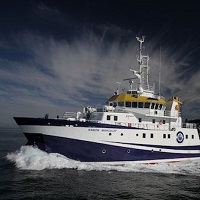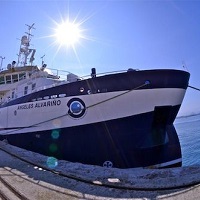Keyword
seismic refraction systems
8 record(s)
Type of resources
Categories
Topics
INSPIRE themes
Keywords
Contact for the resource
Provided by
Years
Formats
Status
-

Study of different sectors of the Mediterranean margins of Andalusia to analyze the potential existing active tectonic structures, capable of generating geological risks either due to the generation of earthquakes, or secondarily due to the triggering of landslides and / or tsunamis.
-

<p>The multi-annual partnership-based research programme SPIRAL (deep seismic and regional investigation in northern Algeria) aims to study the deep structure of the North Algerian margin using "high penetration" seismic methods: low frequency vertical reflection shooting, as well as wide angle reflection and refraction with deployment of listening stations on the seabed and onshore. The first strand of the SPIRAL programme SPIRAL involves the sea cruise to acquire geophysical data. This cruise took place aboard RV L'Atalante in two legs, respectively from 26/09 (Oran) to 10/10 2009 (Annaba) and from 13/10 (Annaba) to 10/11 2009 (Oran). These two legs provided acquisition of wide-angle seismic and penetrating multichannel seismic reflection data, which was the main objective of the project, as well as additional data like very high resolution (Chirp or sediment sounder type), magnetic and gravimetric, and multibeam bathymetric echosounder data. The profiles acquired during SPIRAL should supply elements to characterize the structural levels in and under the sediment cover (crust) down to the mantle in the targeted zones given in the cruise report; obtain accurate images of faulted and folded area and the major boundaries like the Moho; constrain the physical and rheological properties (particularly velocity models) which should help determine things like the nature of the crust at the continent-ocean transition. These constraints will make it possible to perform thermo-mechanical modelling on the scale of the Maghrebide belts to the base of the crust (temperature, density) and thus specify the main boundaries of the large crustal domains.</p>
-

<p>?The cruise took place from 22 November to 20 December 2006 aboard RV L'Atalante. Its objective was to study the formation of passive continental margins and a special sedimentary sequence which exists all over the Mediterranean. The result of national (IUEM Brest, Géosciences Azur, University of Lille, UPMC) and European (Universities of Lisbon and Bologna, GEOMAR and AWI) cooperation, directed by Ifremer, the cruise mobilized some twenty scientists for nearly one month. The related project is GDR Marges.</p>
-

The objective of the NUREIEVA-3D campaign is the acquisition of a high-resolution 3D seismic cube of the submarine extension of the Portmán Bay mining spill deposit, in the vicinity of Cartagena, Murcia province, in order to establish the geometry and three-dimensional internal structure of said reservoir. To carry out the campaign, it will be necessary to install, test and deploy from the ship a complete 3D seismic system that will be provided by the subcontracted company GeoSurveys
-

The main objective of the Idrissi-2016 recovery cruise is to recovery the 10 Ocean Bottom Seismometers and Hydrophones (OBS/H) deployed in the ocean floor during the oceanographic mission Idrissi-2016 accomplished on September 2016. The OBS will have been acquiring earthquake data occurring in the area during 3 months under the sea. Seismic data will determine the shallow and deep crustal structure and plate geometry of the convergent system giving rise to earthquakes as the Mw 6.3 occurred on January 25th 2016, specially along the Al Idrissi fault, possibly the responsible of the geological hazards that threaten the region. In addition, the data acquired will allow improving our knowledge on the tectonics, faults parameters and landslides to define the most significant geological hazards, including large earthquakes and rarely tsunamis. Together with the OBS/H recovery, a detailed bathymetry survey of the Al Idrissi fault will be performed along the fault using hull-mounted echosounders on the vessel.
-

The marine ecosystem of the island of El Hierro, one of the richest and most sensitive of the spanish region, is experiencing the consequences of the first recorded underwater eruption in the Canary Islands in the last 500 years of volcanological history. The principal objective of VULCANO is to characterize the marine ecosystem from a physical-chemical-biological approach in order to quantify the environmental impact caused by the eruptive process. This main aim splits into five particular objectives: 1) to characterize the ecosystem before and after the eruption process, 2) to study the spatio-temporal variability of physical, chemical and biogeochemical properties, 3) to evaluate the impact of the eruptive process on lower trophic levels and 4) Characterization of the physiographic, morphological and structural changes on the seafloor associeted to submarine eruptions and 5) the data integration in existing databases, SIG implementation and dissemination by viewers. These objectives will be accomplished through the development of a multidisciplinary working plan which includes the realization of 3 oceanographic cruises and satellite observations.
-

The main objetive of PLOCAN1310 cruise is twofold. On the one hand implement PLOCAN testing bank area, located in NE coast of Gran Canaria island, and on the other hand, doing seasonal sampling of ESTOC (Estacion de Series Temporales Oceánias de Canarias), which represents PLOCAN node oceanic observatory, located 60 nautical miles north of Gran Canaria island. Hydrological and Geophisical sampling at NER300 area.
-

The marine ecosystem of the island of El Hierro, one of the richest and most sensitive of the spanish region, is experiencing the consequences of the first recorded underwater eruption in the Canary Islands in the last 500 years of volcanological history. The principal objective of VULCANO is to characterize the marine ecosystem from a physical-chemical-biological approach in order to quantify the environmental impact caused by the eruptive process. This main aim splits into five particular objectives: 1) to characterize the ecosystem before and after the eruption process, 2) to study the spatio-temporal variability of physical, chemical and biogeochemical properties, 3) to evaluate the impact of the eruptive process on lower trophic levels and 4) Characterization of the physiographic, morphological and structural changes on the seafloor associeted to submarine eruptions and 5) the data integration in existing databases, SIG implementation and dissemination by viewers. These objectives will be accomplished through the development of a multidisciplinary working plan which includes the realization of 3 oceanographic cruises and satellite observations.
 Catálogo de datos del IEO
Catálogo de datos del IEO